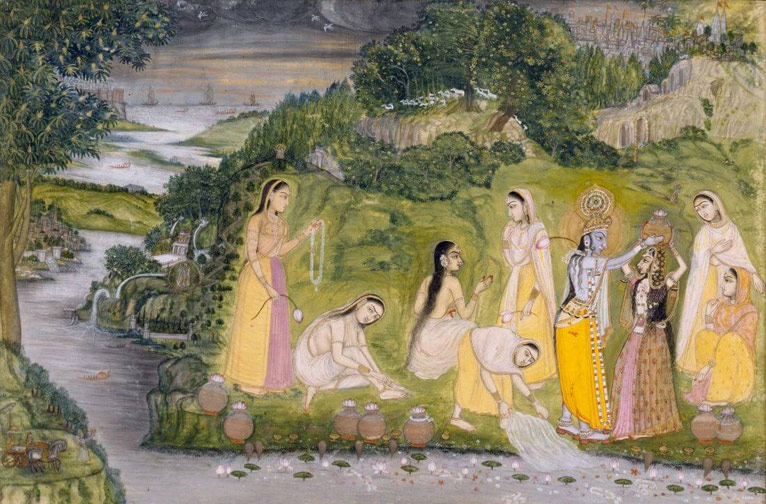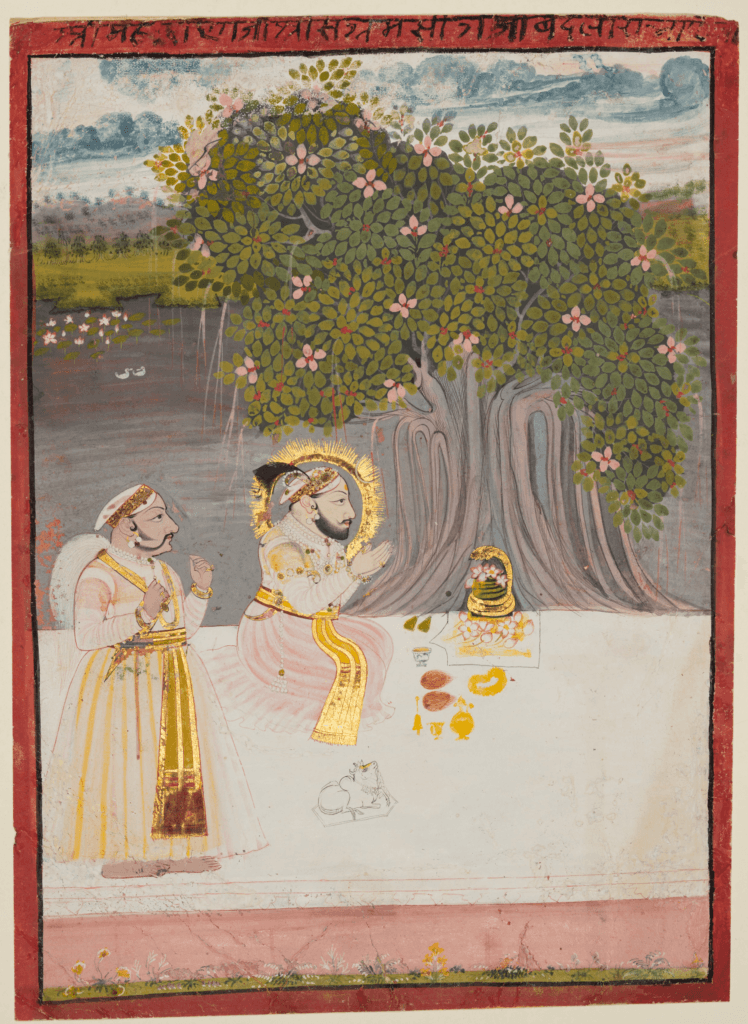The art of painting dates back to prehistoric times. Some of the earliest paintings were discovered on the cave walls of Italy. In India, the Ajanta caves feature exquisite paintings created solely with the shade of red. From those ancient times, the art of painting in India has evolved significantly. In addition to painting, sculptural art in India has also developed through the Mauryan, Gupta, Mathura, and Gandhara styles. Rajasthan is one of the regions in India renowned for its rich painting culture, which stretches back to early medieval times. Painting as a profession is a collaborative effort, requiring master artists to be thorough while drawing. This is followed by applying colours, depicting landscapes, animals, human figures, and architecture. Finally, the artist adds the finishing touches at the end.
Origin of Painting Styles
It is believed theoretically that the artists from the southern regions migrated to the northwestern regions of Rajasthan, where these paintings were formed. The artists might have been expert artists of the Ajanta caves who then reached these regions, where their art style got blended with the local tradition, techniques and folklore culture of the region. The origins of painting in Rajasthan can be traced back to the 16th century. The religious or bhakti movement of Vaishnavism saw the influence of worship of Rama and Krishna growing in parts of Rajasthan. The paintings were usually done around these religious themes, like the ‘Gita Govinda Painting’, which emphasises the devotion of Radha to Lord Krishna. Besides the religious aspect of the paintings in Rajasthan, the royal lifestyle also influenced the growth and change in the style of paintings. There were both frescos and miniature paintings with scenes of Lord Krishna playing his flute and being surrounded by gopikas and cows. The royal paintings include scenes from royal courts with queens and sometimes courtiers, and private gardens.

The theme evolved and flourished into various other forms, and different schools of painting also emerged with time, like the Malwa school of painting, Mewar school of painting, Bundi school of painting, Kota school of painting, Bikaner school of painting, Kishangarh school of painting, Jaipur school of painting, and Jodhpur school. All of these schools created their techniques and themes. The Mughals also had their influence on the mural paintings when the Rajputs had to ally with them. As explained above, the religious scenes with Lord Krishna had a major influence over these various schools of art, which also gave rise to different styles of paintings.
There are various types of Rajasthani paintings which represent the culture and art of their own. And each of the paintings given below has its unique history, too.
Types of Painting Styles
Phad painting
Background: This style originated from Shahpura, which is near Bhilwara, Rajasthan. It has a 700-year-long legacy that has survived through passing down this practice of art from one generation to another within a single family. These paintings are a type of scrolls which elaborate on traditional stories of Gods and Goddesses. Phad is carried by priests and acts like a mobile temple for them. The priests are singers who belong to the Rabari tribe. They are also known as Bhopas and Bhopis, who are experts in singing stories and legends of one of Vishnu’s avatars, ‘Devnaraynji’. The Bhopa or the priest would sing about the story, while his wife or Bhopi, would dance to accompany the song. This scroll painting only resided in the family of Joshi, who belongs to the Chasti caste, and they were also experts at creating these paintings.
Style and Motifs: The Phad painting is usually done on a hand-coarse-woven cotton cloth. The cloth is soaked in water overnight to expand the threads, then it is stiffened with starch from wheat flour or rice, and stretched out to dry in the sun. Moonstone is applied on the surface to smooth it, after that, natural fibres and paints are derived from flowers, plants and stones. These paints are handmade by the artists who would use colours like yellow, orange, brown, green, red, black and blue. Each colour is used for different motifs, like yellow for outlining the ornaments and clothes. Orange colour for torso and limbs, Green for vegetation, Red for royal kind of clothes and flags, Brown for architectural structures, Black is used in ending the outlines and Blue is used for water or even curtains. Eyes are the last motif or design drawn in the painting to give detail. The Gods and goddesses are only completed with drawing the eyes in the final step of this painting.
Miniature painting
Background: This art form emerged in India during the reign of Mughals. The Persian artists were masters in this kind of artform. In the 16th century, Humayun, the second Mughal emperor, invited these artists to decorate his court with detailed and beautiful miniature paintings. Akbar later on encouraged these artists to practise their expertise in India through their workshops. In turn, these Persian artists introduced Indian artists to this artform. Since then, this artform has largely influenced Rajput paintings till today.
Style and Motifs: The schools mentioned above had their own distinctive style of creating miniature paintings. For instance, in Mewar school of painting there were distinct motifs like, the human figures in the painting would have oval or rounded faces, with elongated almond shaped eyes and sharp noses. The men in the painting would wear loose garments with embroidered turbans, while the women were drawn shorter than the men, who would wear long ghagra cholis and transparent dupattas. The painting contained vibrant colours and lush vegetation with landscapes of Mewar.

Bhitti Chitra (Wall Painting)
Background: This particular painting was usually done on walls, for instance, Madan Mohan Mandir is a famous example, which has paintings adorning its walls. The date of this painting is still debated to this day, but it is believed to be 200 years old by some scholars. It usually depicts religious themes and is created by ‘Matherans’, who are also known as the Mahatma community in Rajasthan.
Style and Motifs: The painting usually depicts patrons and their families. The artist uses the ‘utsa’ technique to enhance the painting with the help of gold and silver to emboss the painting. The paintings are usually crowded with human figures, plants, and animals. The painting also depicts Durga Shaptshati, Ramayana, and Dashavatar, ceremonial scenes of marriage and festivals, which are present in the painting.
Present Scenario
In the modern world, these paintings are fading away with time, as their only source or their representation is left in the tourism sector. But there are artists in Rajasthan who are still ready to teach and pass down their technique of art to the next generation. Padma Shri awardee, S. Shakir Ali, is one of the famous artists who is an expert in miniature paintings. For recent years, he has been giving workshop classes at Rajasthan Studio to new artists who are keen to learn this Mughal art style. Pradeep Mukherjee is another great master artist who is trying his best to keep the art of Phad paintings alive by passing this art to new artists.

Conclusion
The tradition of these paintings, just like other floral arts in Rajasthan, might fade away in a few years. It can continue to survive if the government initiates new schemes and workshops to keep these art styles alive. Painting styles like Gemstone, Kajali, Pichwai, Kishangarh, Sanjhi, and Bani Thani are also under the threat of being erased from the folk arts of Rajasthan. If this kind of art form is introduced into the pop culture of today, then there might be a good chance to make these art forms relevant for this modern world.
Sources Used:
Some, A. (2021, April 24). Historical paintings of Rajasthan. The Social Stays. https://www.thesocialstays.com/blogs/art-blog/historical-paintings-of-rajasthan
Phad Paintings of Rajasthan – a tale of tradition, storytelling and revival in the modern day. (n.d.). Artisera. https://www.artisera.com/blogs/expressions/phad-paintings-of-rajasthan
Support, V. C. (2023, August 28). Miniature painting of Rajasthan. VarEesha. https://vareesha.com/blogs/news/rajasthani-miniature-painting
Rooftop. (2024, November 18). Exploring the timeless beauty of Mewar miniature paintings. Rooftop. https://rooftopapp.com/blogs/exploring-the-timeless-beauty-of-mewar-miniature-p
Bhitti Chitra – Wall Painting of Rajasthan – Asia INCH – Encyclopedia of Intangible Cultural Heritage. (n.d.). Asia InCH – Encyclopedia of Intangible Cultural Heritage – Open Educational Resource on the Intangible Cultural Heritage of the Traditional Arts, Crafts and Textiles and Their Practitioners and Transmitters in South Asia. https://asiainch.org/craft/bhitti-chitra-wall-painting-of-rajasthan/
Community, D. C. (2020, February 17). Bhitti Chitra Kala from Bikaner, Rajasthan – Direct Create – Medium. Medium. https://medium.com/direct-create/bhitti-chitra-kala-from-bikaner-rajathan-4d1828abe7f4
Rajasthan Studio. (2024, December 6). 9 Popular Painting Styles of Rajasthan – Rajasthan Studio. Rajasthan Studio – Art experiences hub. https://rajasthanstudio.com/9-popular-painting-styles-of-rajasthan/





